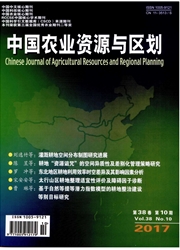

 中文摘要:
中文摘要:
城乡建设用地置换是有效缓解“耕地保护”与“建设占用”、“城市建设用地短缺”和“农村建设用地闲置”这两对矛盾的重要途径,然而近年来我国城乡建设用地置换风险频现,违背了原有保护耕地和节约集约利用土地的政策设计初衷,也影响了城乡统筹发展和社会稳定。针对此状况,在总结我国城乡建设用地置换研究的现状后,对比国外相关研究,指出我国城乡建设用地置换研究存在理论基础薄弱,定量分析不足等缺点。基于运行机理一风险识别一制度优化的思路,建议今后城乡建设用地置换研究可以着重从4方面入手:从利益主体的角度研究置换的运行机理,针对需求不足的问题研究需求机制,识别风险因子并模拟整体风险状况、运用倒推法提出相应的优化政策包。通过上述研究以实现城乡建设用地置换研究的理论创新,为我国城乡建设用地置换风险防控和优化管理提供定量化的决策支持。
 英文摘要:
英文摘要:
Urban and rural construction land replacement is an effective way to alleviate two contradictions between the " cultivated land protection" and " construction usage", and between " urban construction land shortage" and " unused rural construction sites". In recent years, however, the risks of the urban and rural construction land replacement appear frequently, which has not only violated the policy - designed original intention of protec- tion of farmland, the frugal and intensive utilization of land, but also affects urban and rural development balance and social stability. According to this instance, the study summarized the status quo of the urban and rural con- struction land replacement and found some disadvantages such as the weakness of theoretical foundation, the defi- ciency of quantitative analysis comparing with the foreign related study. Based on the ideal of operational mecha- nism - risk identification - the thought of institutional optimization, this paper suggested ( 1 ) to study the opera- tional mechanism of replacement from the angle of interest subject, (2) to study the demand mechanism targeting at the demand deficiency, (3) to identify risk factors and stimulate the whole risk status, (4) to put forward cor- responding optimization policy package by applying the backward inference method. It aimed to realize the theoreti- cal innovation and give quantization decision - making support to the risk prevention and optimal management of the urban and rural construction land replacement of our country.
 同期刊论文项目
同期刊论文项目
 同项目期刊论文
同项目期刊论文
 期刊信息
期刊信息
